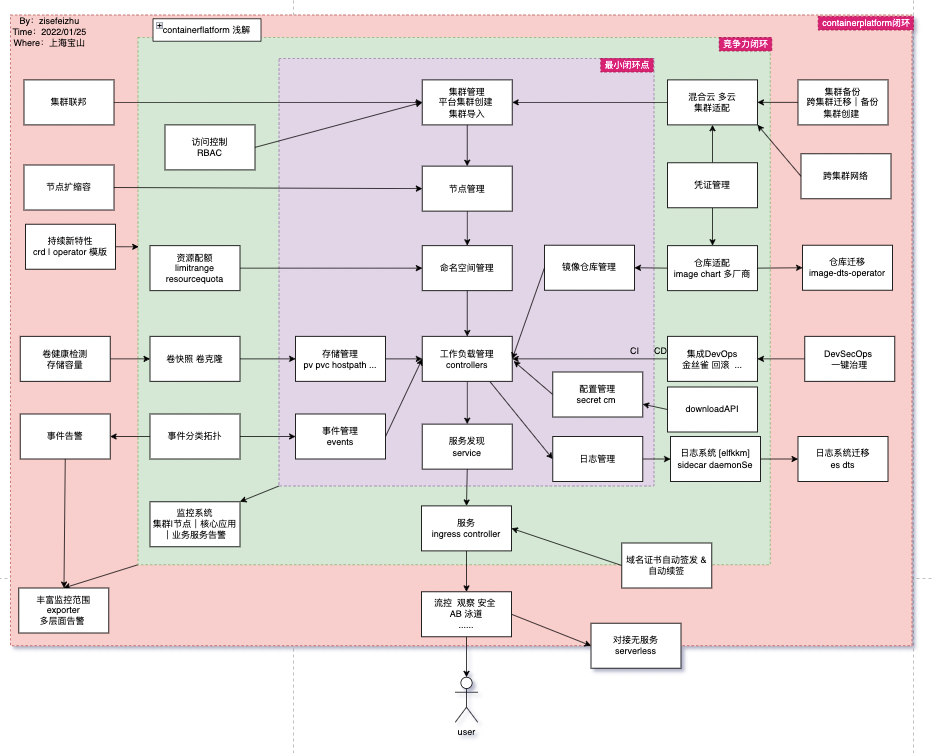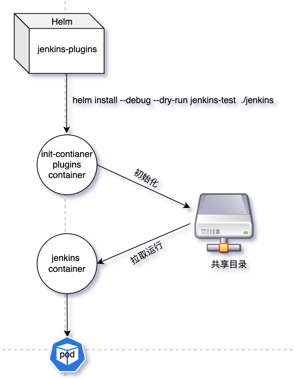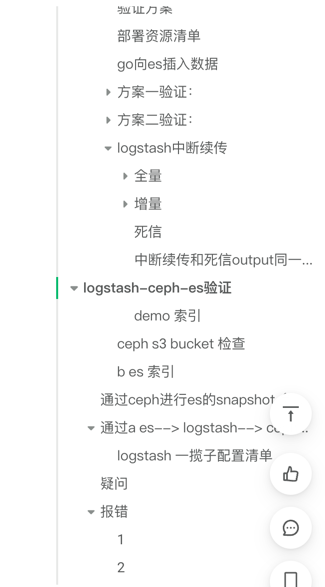做微服務研發工程師的一年來的總結
前述
18年的那個留校夏天,極其偶然接觸到了《Docker+Kubernetes》,由純運維的發展方向轉到了雲原生的發展方向。19年5月以《linux helmsman platform》獲得IT創新大賽二等獎,其實質是圍繞雲原生的邊側服務整合部署。20年5月以《基於Kubernetes的舵手叢集系統的設計與實現》獲的河南省優秀畢業論文,其實質是在《linux helmsman platform》的基礎上進行修補程式而成。20年6月初在創業型公司做唯一的雲原生運維,那是段足以影響一生的經歷:https://www.cnblogs.com/zisefeizhu/p/14601287.html 。
21年6月底極其偶然的機會(面的kubernetes運維崗,入職了微服務研發工程師崗)來到這家公司以微服務研發工程師的角色實質開啟純研發歷程,至今已一年有餘。在專案空閒期回憶這一年的路程,承上啟下。
一年來做的專案
這一年來重點圍繞以下專案展開:
1)、 獨立開發xxx專案的混合雲容器模組:運用go+gin+gorm+mysql+client-go+kubernetes技術棧,實現對kubernetes叢集的建立/匯入、節點的管理、名稱空間的管理、工作負載的管理、設定中心的管理、...、憑證的管理、映象倉庫的適配(harbor/acr/ccr/aws)、叢集的適配(tke/ack/aws/自建叢集)、等功能。總的來說此專案主要是api的對接,並不具備複雜的技術棧,在實際開發中最大的收穫是:1、根據需求實現業務的開發考量 2、對各廠商的欄位封裝 3、開發中遇到問題的實際處理(1、返回錯誤資訊 2、列表類介面的錯誤處理 3、資料庫欄位的設計 4、api介面的設計 5、適配層的轉換 6、面向錯誤的開發)。期間思考了下圖
- ps:上圖只是個人對容器平臺的構想,實際專案中並沒有用此構思,所以談不上涉密問題。
func Init(g *gin.Engine) {
// 跨域
g.Use(Cors())
// 定義輸出紀錄檔格式
g.Use(middleware.LoggerToFile())
g.Any("/", v1.Hello)
g.GET("/health", v1.Health)
api := g.Group("/container/api")
clusterRouters(api)
nodeRouters(api)
nsRouters(api)
workloadRouters(api)
podRouters(api)
pluginRouters(api)
registryRouters(api)
credentialRouters(api)
configRouters(api)
csiRouters(api)
g.GET("/swagger/*any", gs.WrapHandler(swaggerFiles.Handler))
}
2)、根據開發devops同事的需求,獨自設計與實現(運用helm+kubernetes技術棧)jenkins叢集+外掛的一鍵部署。總體來說此專案並不複雜,更多的是考驗helm的書寫與合理的利用kubernetes的特性。實際構思圖如下:
# Default values for jenkins.
# This is a YAML-formatted file.
# Declare variables to be passed into your templates.
# By zisefeizhu
# Time 2021年 8月26日 星期四 10時45分56秒 CST
# namespaceOverride jenkins部署到的名稱空間
namespaceOverride: devops
securityContext:
enabled: true
privileged: true
runAsUser: 0
# replicaCount 副本數
replicaCount: 1
# image 映象資訊
image:
repository: registry.cn-shenzhen.aliyuncs.com/zisefeizhu/annet
pullPolicy: IfNotPresent
# Overrides the image tag whose default is the chart appVersion.
tag: "jenkinsci-blueocean-v0.1.1"
baseImageTag: "jenkins-plugins-v0.1.4"
# dockerRegistry Concentrated verification of consciousness
dockerRegistry:
enabled: true
secretName: jenkins
user: xxxx
password: xxxxxx
# containerPorts jenkins pod 埠
containers:
ports:
- containerPort: 8080
name: web
protocol: TCP
- containerPort: 50000
name: agent
protocol: TCP
nameOverride: ""
fullnameOverride: ""
serviceAccount:
# Specifies whether a service account should be created
create: true
# Annotations to add to the service account
annotations: {}
# The name of the service account to use.
# If not set and create is true, a name is generated using the fullname template
name: ""
# service 型別和埠資訊
service:
ports:
- name: web
port: 8080
targetPort: web
nodePort: 31031
- name: agent
port: 50000
targetPort: agent
type: NodePort
# port: 31031 #埠
# pvc的access型別
pvc:
enabled: true
scName: xxxx
accessModes: ReadWriteMany
storage: xxx
ingress:
enabled: false
className: ""
annotations: {}
# kubernetes.io/ingress.class: nginx
# kubernetes.io/tls-acme: "true"
hosts:
- host: chart-example.local
paths:
- path: /
pathType: ImplementationSpecific
tls: []
# - secretName: chart-example-tls
# hosts:
# - chart-example.local
# resources limit range obtained from pressure measurement
resources:
enabled: falase
limits:
cpu: 1
memory: 1Gi
requests:
cpu: 200m
memory: 512Mi
# startupProbe 存活性探針
startupProbe:
enabled: false
probe:
failureThreshold: 3
httpGet:
path: /login
port: 8080
scheme: HTTP
initialDelaySeconds: 30
periodSeconds: 10
successThreshold: 1
timeoutSeconds: 1
# livenessProbe 存活性探針
livenessProbe:
enabled: false
probe:
failureThreshold: 3
httpGet:
path: /login
port: 8080
scheme: HTTP
initialDelaySeconds: 30
periodSeconds: 10
successThreshold: 1
timeoutSeconds: 5
# readinessProbe 就緒性探針
readinessProbe:
enabled: false
probe:
failureThreshold: 3
httpGet:
path: /login
port: 8080
scheme: HTTP
initialDelaySeconds: 30
periodSeconds: 10
successThreshold: 1
timeoutSeconds: 5
autoscaling:
enabled: true
minReplicas: 1
maxReplicas: 10
targetCPUUtilizationPercentage: 80
targetMemoryUtilizationPercentage: 80
3)、根據架構師構思(16年工作經驗),獨自驗證/輸出檔案,運用:logstash+ceph+operator技術棧。實現es叢集之間的全量/增量/全量+增量同步遷移、持久化佇列/死信等功能。此專案具有一定複雜度。在實際開發中需要1、對logstash有一定程度的運用(需要對涉及到的功能點進行一一驗證實踐)、2、對operator有一定的掌握(特別是對spec和status的深度理解)。3、對k8s有較深度的掌握,理解涉及到的核心資源的運用。
- 架構圖及原始碼涉密。
4)、近期為了加深operator的理解,寫了workload-operator,實現對deployments/statefulsets/daemonsets/cronjobs/jobs/services 功能的封裝。本專案為個人專案,難點在對個控制器的理解與status的處理。
func (r *WorkloadReconciler) Reconcile(ctx context.Context, req ctrl.Request) (ctrl.Result, error) {
_ = r.Logger.WithValues("workloads", req.NamespacedName)
forget := reconcile.Result{}
requeue := ctrl.Result{
RequeueAfter: time.Second * 2,
}
instance := &workloadsv1alpha1.Workload{}
if err := r.Get(ctx, req.NamespacedName, instance); err != nil {
return forget, client.IgnoreNotFound(err)
}
// 進入矯正
if instance.Status.Phase != workloadsv1alpha1.RunningPhase {
// 這裡料想複雜
// todo 再優化
err := r.workloadCorrectionProcessor(&instance)
if err != nil {
return requeue, err
}
}
// 優先 svc 處理邏輯
svcStatus, err := r.svc(ctx, instance)
if err != nil {
er := r.workloadPhase(ctx, instance, workloadsv1alpha1.FailedPhase)
if er != nil {
return requeue, er
}
return requeue, err
}
// 工作負載 處理邏輯
dgStatus, err := r.deploymentGroup(ctx, instance, req)
if err != nil {
er := r.workloadPhase(ctx, instance, workloadsv1alpha1.FailedPhase)
if er != nil {
return ctrl.Result{}, er
}
return requeue, err
}
// wk 的 status 更新處理
err := r.workloadStatus(ctx, instance, dgStatus, svcStatus)
if err != nil {
return requeue, err
}
return forget, nil
}
operator 的書寫邏輯 圍繞以下四點即可:
觀察:通過監控Kubernetes資源物件變化的事件來獲取當前物件狀態,只需要注入EventHandler讓client-go 將變化的事件物件資訊放入WorkQueue中
分析:確定當前狀態和期望狀態的不同,由Worker完成.
執行:執行能夠驅動物件當前狀態變化的操作,由Worker完成.
更新:更新物件的當前狀態,由Worker完成.
5)、最近在看同事的xxx專案的devops模組,有所感悟:1、開發對需求的實現能力外,其實也應該對要實現的功能有一定的理解。2、對於中介軟體的掌握(比如Jenkins 的pipeline的書寫)。
6)、這一年還幫助同事處理運維問題,幫助同學處理運維問題,也接過外快處理運維相關的問題,也基本每週都抽時間看看雲原生相關的知識。偏向開發是必然要的,運維也是規劃的重點,需要有意多接觸。
綜上,其實在過去的一年的開發嚴格意義還是圍繞雲原生在進行,也符合對職業生涯的規劃:運維 --> 雲原生運維 --> 容器開發(運維開發) --> sre(偏向開發的運維崗) -->
一年來的收穫
這一年來收穫很多,依如20年的運維工作一樣,對職業產生深遠影響:
1、查詢資料由csdn/部落格園 --> github/官網
2、研發能力由面向百度 --> 面向google/pkg
3、由遇到問題就請教同事 --> 和同事探討/自我處理
4、由在一家初創企業 --> 一家還算適中的公司
展望下一年
在接下來的一年,重點實現以下幾點:
1、鞏固已掌握的
2、具備獨立解決問題的能力
3、不斷降低bug率 ,做到需求即理解、理解即實現、實現即交付。
4、對服務治理、微服務、資料庫中介軟體、serverless 、演演算法 展開攻關
5、跳槽 ,再入江湖,出道下山、世界這麼大
特別感謝
以如20年的貴人,阿里雲MVP 如今入職位元組的石老大一樣,在過去的一年,遇到了我飛飛哥哥,不斷騷擾與學習他的長處,嘿嘿嘿。
未來一年,依然堅信,懂雲原生的go開發 是屬於當下及未來一個時期的所需。凡是過往、皆為序章。


